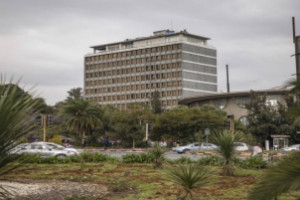
The Ethiopian government has implemented several agricultural strategies to increase the production and productivity of the agricultural sector. Among the activities carried out in the sector, irrigation development, especially summer irrigated wheat development, which was implemented in conjunction with the activities carried out to increase the production and productivity of the harvest and autumn seasons, is noteworthy.
This development has resulted in a significant change in the country’s wheat imports in a short period of time. The realization of summer irrigated wheat development has enabled farmers to produce throughout the year by implementing irrigation development in addition to their rain-fed agricultural activities.
In this regard, the Green Legacy, which has created favorable conditions for fruit cultivation, and Yelemat Tirufat, which has created favorable conditions for fruit and vegetable cultivation, have been implemented in conjunction with the harvest and autumn, as well as summer irrigation activities, and tangible changes are being recorded.
The country’s productivity gains, especially in the field of summer irrigated wheat, are completely changing the narrative of aid-seeking. The country has now gone from covering its own wheat needs to exportation, thanks to the continuous growth of its agricultural production. The main reason for these results is the special attention the government has given to the sector.
The government has been increasing its capacity to increase production every year, and has also been focusing on development in a way that will benefit the citizens. In order to fulfill its responsibility of ensuring food sovereignty for the people of the country, it has continued to work with determination by providing inputs such as fertilizers and high-quality seeds, which are essential for increasing productivity, and by monitoring the preparatory work down to the ground.
Significant progress has been made in both areas, including increasing the coverage of arable land and expanding the use of tillage, which is believed to create favorable conditions for mechanized farming.
Recently, Prime Minister Abiy Ahmed (PhD) appeared at the House of People’s Representatives and responded to questions from members of the House. He said that, in the past five to six years, the coverage of smallholder farmers’ crops has increased from 17.5 million hectares to 20.5 million hectares this year alone.
”This is a major achievement, noting that 8.7 million hectares of land had been covered by tillage until last year and that this figure has been increased to 11.8 million hectares this year,” the Prime Minister announced.
Not only land coverage but also the cultivation of cluster farming has shown great progress. He also indicated that the government will work to increase the productivity achieved by utilizing the available natural resources and favorable conditions; and to ensure its continuity.
It is planned to increase the production and productivity of farmers in the 2025 autumn season. According to Isaias Lemma, Chief Executive Officer of Crop Development at the Ministry of Agriculture, in the 2025 autumn season, it is planned to cultivate 3.7 million hectares of land and produce 99,235,463 quintals of produce.
Accordingly, preparatory work has already begun in the autumn-growing areas of East Amhara, Southern Tigray, Lower Oromia, Central Ethiopia, Sidama, Southwest and most of the Southern Ethiopia Region. Most of the zones in the Somali region are areas where the autumn rains arrive late, but the preparations are being made in a coordinated manner with the farmers.
So far, 2,441,045 hectares of land has been cultivated this autumn, of which 222,334 hectares has been covered with seeds. Of this, 19,727 hectares of land has been cultivated in cluster farming.
Isaias stated that the federal government is working on concrete works by formulating crosschecking plan and coordinating with the regional governments to ensure the continuity of farmers’ productivity. He noted that in particular, the process of providing farmers with complete access to fertilizer and seeds, which are crucial for productivity, has improved compared to previous years.
“This year, in a special way, fertilizer has been purchased in advance, not only for the harvest season but also for the autumn; previously, there was no such thing as fertilizer being purchased in advance,” he said. However, now, fertilizer has been delivered to areas where most of the autumn crops are grown, taking into account their sowing season.
Similarly, the Chief Executive Officer said that a joint effort has been made with the regions and seed multiplying bodies to resolve the problems related to the supply of quality seeds. He also pointed out that the distribution was carried out in a manner that took into account the season and based on the needs of the farmers. In particular, the Ministry of Agriculture has been able to ensure a better seed supply this year through the three-year plan it has worked with the regions to solve the problem of seeds.
On the other hand, according to the ministry’s information regarding the multiplication of quality seeds; during the 2024 crop season, 148,043 hectares of high-quality seeds were planted by government seed producers and private seed companies (Ethiopian Agricultural Enterprises Corporation, Cortiva, Bayer Life and Vamber) and in the regions (Oromia, Amhara; Central Ethiopia, Sidama, Tigray, Southwestern Ethiopia and Somali). As a result, 1,057,155 quintals of seed was harvested from 83,635 hectares of land.
In addition, one of the agricultural activities being carried out to increase and sustain the country’s productivity is to provide timely and equitable access to fertilizer to farmers.
In this regard, it is recalled that the Ministry of Transport and Logistics recently announced that 964,118.1 metric tons of soil fertilizer had arrived at the port of Djibouti. Of this, 836,253.2 metric tons of soil fertilizer was transported into the country and 127, 864.9 metric tons are at the port. Of the transported fertilizer into the country, 523,375.2 metric tons was dap and 312,878 metric tons was urea soil fertilizers.
He indicated that during the autumn season, mostly cereals crops and to some extent pulses are produced; crops such as maize, sorghum, barley and teff, which are in high demand among farmers, will be widely produced this year. “Especially in maize, seed distribution activities have been carried out at the regional and federal levels to address the shortage,” he said.
He also mentioned that fertilizer and seed supply and the overall autumn harvest process are being monitored and evaluated every three days at both the federal and regional levels; efforts are being made to address gaps and achieve better performance.
On the other hand, with the late start of this year’s autumn rains, concerns are being raised by various parties that the expected production in autumn-growing areas may not be as expected; Isaias, when asked what he had to say on this, said that most autumngrowing areas of the country are receiving normal rainfall this year. Efforts have been made to encourage farmers in these areas not to be distracted by the delayed rains and to get started on preparations.
Recalling that the rain was late in the first few weeks of the autumn season, most of the autumn-growing areas are currently receiving normal rainfall. The National Meteorological Institute’s forecast also shows that there is a better distribution of rainfall, Isaias said, adding that there is a possibility of an increase in the distribution of rainfall in the coming days. Farmers will be prepared in advance and work will be done to ensure that they sow their seeds.
Amhara region is one of the regions where this year’s autumn rain has come late; in this regard, the Chief Executive Officer was asked if there is a plan to overcome this in the region for the next crop season; noting that normal rainfall is being received in Amhara and most of the autumn-growing areas, “So far, out of the 239,000 hectares of land planned to be cultivated in Amhara region, 224,000 hectares have been cultivated,” he said. Efforts will be made to achieve the remaining plan by utilizing the available moisture, and there will be no work that will be carried over to the next production season.
On the other hand, the Ethiopian Meteorological Institute’s latest weather forecast report shows that; in the next ten days, favorable weather conditions are expected for the growth of autumn crops in most of the country’s autumn-growing areas.
The information indicated that the rain expected in the coming days will improve soil moisture, which will also have a positive impact on pasture grass and drinking water supply. He indicated that weather conditions conducive to rain formation will continue to strengthen and that areas benefiting from autumn rains will receive light to moderate rainfall covering many areas.
Isaias urged everyone to do their part in order to achieve the planned production level by utilizing the rainy season and all the available moisture.
BY BACHA ZEWDIE
THE ETHIOPIAN HERALD SUNDAY EDITION 6 APRIL 2025





